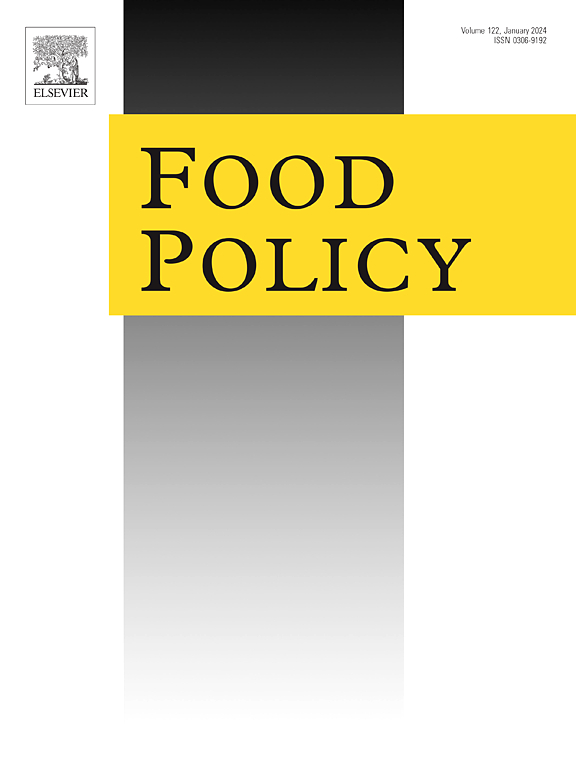Assessing water-energy-food nexus efficiency for food security planning in China
IF 6
1区 经济学
Q1 AGRICULTURAL ECONOMICS & POLICY
引用次数: 0
Abstract
Incorporating food security into the water-energy-food nexus, thereby establishing a water-energy-food-food security (WEF-FS) system, fosters multifaceted challenges of achieving food security. An extended dynamic series-loop data envelopment analysis model assesses WEF-FS efficiency by analyzing element interactions to identify inefficiencies and improvements. Kernel density estimation and standard deviation ellipse analysis explore spatiotemporal trends and provincial discrepancies in WEF-FS efficiency, guiding targeted policies. A two-way fixed effects model is constructed to investigate the impact of climate change on the WEF-FS efficiency. Findings include: (1) The proposed model efficiently handles interlinked activities within a unified framework. The average overall efficiency of China’s WEF-FS system during 2011–2021 across 30 provinces was 0.77. Eastern regions excelled in water/energy subsystems, while western regions performed better in food/food security subsystems. (2) Provincial disparities in WEF-FS efficiency narrowed from 2013 to 2021, but issues related to food affordability, quality and safety remained critical challenges, particularly in the central region. Spatial variations aligned with a northeast-southwest axis, with the efficiency centroid in Henan shifting southeastward. (3) Climate change reduced WEF-FS efficiency via temperature and precipitation; Major Grain-Producing Regions buffer while Non-Major Grain-Producing Regions face tech-driven losses, with post-2016 reforms reversing impact. Regional characteristics must inform food security planning.
中国粮食安全规划中水-能-粮联系效率评估
将粮食安全纳入水-能源-粮食关系,从而建立水-能源-粮食-粮食安全体系,将促进实现粮食安全的多方面挑战。一个扩展的动态序列-循环数据包络分析模型通过分析元素的相互作用来评估WEF-FS的效率,从而识别低效和改进。核密度估计和标准差椭圆分析探讨了世界经济论坛效率的时空趋势和省域差异,为有针对性的政策提供指导。建立了双向固定效应模型,探讨了气候变化对世界经济论坛效率的影响。研究结果包括:(1)提出的模型在统一的框架内有效地处理相互关联的活动。2011-2021年,中国30个省份的世界经济论坛-论坛体系平均整体效率为0.77。东部地区在水/能源分系统中表现突出,西部地区在粮食/粮食安全分系统中表现突出。(2) 2013 - 2021年,世界经济论坛-论坛效率的省际差异有所缩小,但与食品价格、质量和安全相关的问题仍然是严峻的挑战,特别是在中部地区。空间变化以东北—西南为主轴,效率质心向东南移动。(3)气候变化通过温度和降水降低了WEF-FS效率;主要产粮区有缓冲,而非主要产粮区面临技术驱动的损失,2016年后的改革将扭转影响。区域特征必须为粮食安全规划提供信息。
本文章由计算机程序翻译,如有差异,请以英文原文为准。
求助全文
约1分钟内获得全文
求助全文
来源期刊

Food Policy
管理科学-农业经济与政策
CiteScore
11.40
自引率
4.60%
发文量
128
审稿时长
62 days
期刊介绍:
Food Policy is a multidisciplinary journal publishing original research and novel evidence on issues in the formulation, implementation, and evaluation of policies for the food sector in developing, transition, and advanced economies.
Our main focus is on the economic and social aspect of food policy, and we prioritize empirical studies informing international food policy debates. Provided that articles make a clear and explicit contribution to food policy debates of international interest, we consider papers from any of the social sciences. Papers from other disciplines (e.g., law) will be considered only if they provide a key policy contribution, and are written in a style which is accessible to a social science readership.
 求助内容:
求助内容: 应助结果提醒方式:
应助结果提醒方式:


